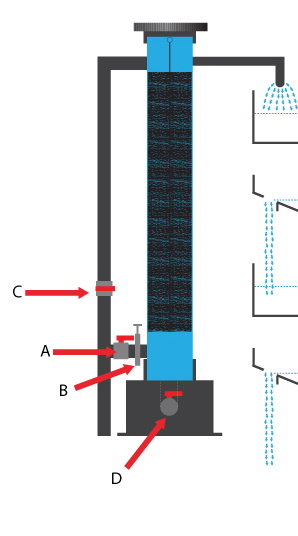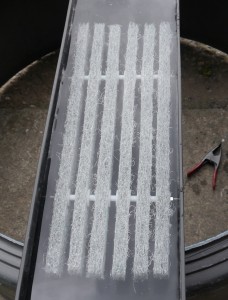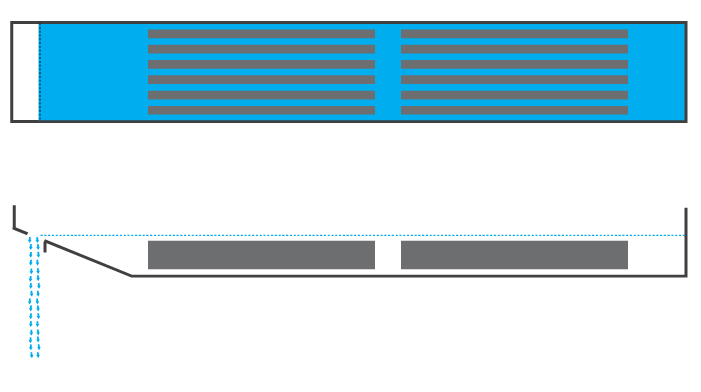Latest news – 26/07/12.
Well, it’s the initial illustration of another variation of mechanical and biological pond filtration soon to be added to the Eric range of fishpond filters.

The principle behind this is no different to the principle used in the existing tried, tested and proven range of Eric units – namely it’s a river or perhaps I should really call this one a stream?
This stream is only 8.5” (21.5cms) wide; it’s only 3.75” (9.5cms) deep, however it’s almost 19.5 feet (6 meters) long.
The first prototype will be available for testing in the next few days when the design and operation will be much clearer after further photographs have been taken.
I must make it clear that although there are four trays shown above each other, this has NOTHING at all to do with any shower system.
Exactly like the standard Eric units, this will use filter brush for the mechanical stage and EricMat media blocks for the biological stages.
THE MECHANICAL STAGE
 The long 1.5” pipe to the left will be supplied water from a pump – all these units will be pump-fed although it is simple to also supply water via a 4” bore bottom drain line.
The long 1.5” pipe to the left will be supplied water from a pump – all these units will be pump-fed although it is simple to also supply water via a 4” bore bottom drain line.
In normal running valve ‘C’ will be closed and water will enter the tube through the part-open valve ‘A’ on a 1” bore line.
It should be explained here that whilst the water pump may be capable of pumping 1,500 gallons per hour through the 1.5” tube, valve ‘A’ will control this to a far lower flow-rate.
The main tube itself is in clear UPVC, which is 110mm in diameter and only holds 2 gallons of water. This is welded to the base of the unit as shown and then connected to the 2” ball valve ‘D’ via 2” tube and fittings. Valve ‘D’ is also closed in normal running of the unit.
After the exit of the 2” tube has been securely welded to the outside of the base, the inside of the base is filled with sand and then the final base is attached which gives real stability for outdoor installations.
The filter brush used here is a single 4” diameter double-crimped polypropylene brush – exactly like those used in Eric brush boxes but this is 35” (90cms) long and made specifically to fit tightly inside the clear tube.
Flow-rates on these units are intentionally low and in most applications may be running at around only 550 gallons (2,500 litres) per hour although flow-rates double this flow will be possible.
The 1” bore tube at the top right will take pond water into the biological stages.
It should be obvious to see that all water entering the biological stages MUST first rise and pass through the brush barrier and the clear tube also allows any debris deposited in the brush to be seen clearly. At the low flow-rates specified I doubt if any debris will get past the first 25% of the brush.
To discharge and clean this stage thoroughly, valve ‘D’ should be opened to waste, valve ‘C’ opened fully and valve ‘A’ must be closed. When valve ‘C’ is fully opened this allows the water pump to operate at full bore and this will force a head of water down through the brush and take all debris to waste in a matter of seconds. Once again, the clear tube will allow all this to be witnessed.
The very top of the tube is fitted with a screwed cover that allows for the brush to be lifted out and the inside walls rinsed should algae on the clear tube ever become a problem.
THE BIOLOGICAL STAGES.
This is a close-up of the EricMat blocks to be used in these trays. The six strips used in each block are cut from two standard sheets of EricMat.
There are two blocks in each tray and thus eight blocks in the four trays.
Water is allowed to pass freely around all surfaces and there’s also a 0.75” space of water allowed to pass above and below these blocks to ensure every part of the EricMat is used.
Hopefully the plan and section shot below gives a better indication.
The water exiting all trays has to fall 6” before reaching a lower tray and this alone should do away with the need for supplementary aeration from an air pump.
Incidentally these four trays are completely independent of each other and can be slid out and checked at any time.
There’s much more information to all of this which will be supplied in the very near future.
There’s less than 25 gallons of water in the total system when running normally.
Believe me, I’m getting quite excited!
I’ve already disproven the age-old myth that deep ponds need deep filters, now I’d like to address the flow rate theory where we’ve all been led to believe that the more water that passes through the filter, the better the results will be?
Forgive me, but I believe it’s the direct opposite!
I reckon there’s good chance of putting this system on a 3,000-gallon pond with only a miserly flow-rate of 600gph and getting truly amazing results in both water clarity and water quality.
That’s only once in every FIVE hours that the total pond volume is passed through the filter, which should raise a few confused eyebrows from the traditionalists and also more than a few frowns from the electricity suppliers.
And 50% of this is down to the horizontal flow principle – the other 50% is down to the amazing properties of the EricMat sheets!
Ooops, almost forgot…..
Just imagine a U/V unit being fitted into the line between the water pump and the 1” inlet with a flow-rate through the U/V at only 600gph?
Now that’s when a U/V unit REALLY performs!
All I have to do now is to come up with a good name for the contraption………..
Waddy.


